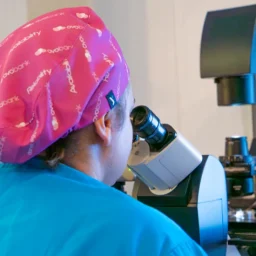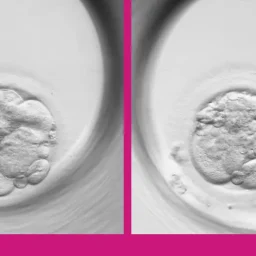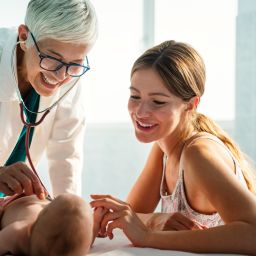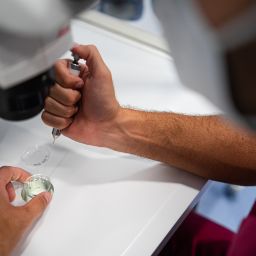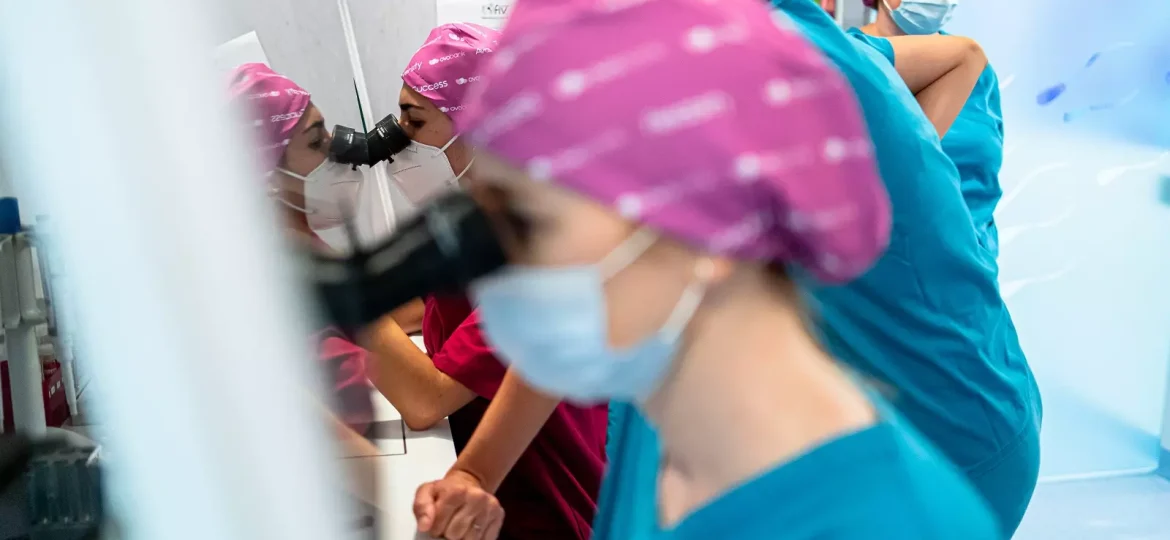
According to the World Health Organisation (WHO), endometriosis affects approximately 190 million women and girls of reproductive age worldwide, i.e. about 10% of this population group (13). It is a chronic, painful disease in which tissue similar to that lining the inside of the uterus grows outside the uterus. It often affects the ovaries, fallopian tubes and the tissue lining the pelvis. In fact, endometriosis is one of the most common diseases that make pregnancy impossible, depending on the severity of the disease. At present, there is no treatment available to cure it, so the aim is usually to alleviate the symptoms. Below, we will go into the subject in depth and discover which assisted reproduction techniques are the most efficient for women suffering from endometriosis.
What are the diagnosis and symptoms of endometriosis?
In symptomatic women with endometriosis, the main and most frequent symptom is cyclical pelvic pain, which adopts different patterns: severe dysmenorrhoea (75%), which is usually progressive, severe dyspareunia (44%), chronic pelvic pain (70%), pain limited to ovulation and/or dyschezia (11). These symptoms around menstruation may be associated with abnormal bleeding or bowel and bladder symptoms up to infertility and/or chronic fatigue (11).
Early work by Sampson (17) described the association of peritoneal endometriosis secondary to menstrual shrinkage within the peritoneal cavity. Subsequently, numerous authors have described the endometriosis-myoma association. However, the same frequency of myoma with and without endometriosis has been described in women with fertility problems. Similarly, while initial retrospective and uncontrolled studies reported a higher frequency of miscarriage in women with endometriosis, subsequent controlled studies have shown no difference in the rate of miscarriage (9).
The guidelines and diagnostic tests on which the diagnosis will be based are the clinical history and physical examination of the woman.
Establishing the diagnosis of endometriosis on the basis of symptoms alone is difficult because the presentation is highly variable, the predictive value of any of them (individually or grouped together) is doubtful and there is overlap with other conditions of various pathologies such as intestinal pathologies, resulting in a delay of several years in the definitive diagnosis (7).
There are many pathologies that may raise doubts as to whether the origin of the pain is endometriosis or another situation, so diagnostic tests are essential to be able to make a differential diagnosis of pain (11). The most common symptomatology in patients with endometriosis can be classified as follows:
- Pain:
– Dysmenorrhoea that does not subside with usual treatment.
– Chronic pelvic pain
– Severe dyspareunia
– Cyclic dyschezia with or without rectorrhagia - Infertility.
Fertility loss and endometriosis
Although there is a clear association between endometriosis and infertility, the mechanism by which this occurs is unknown and the explanation of a cause-effect association remains highly debated. Infertility is a major associated problem affecting more than 30% of women with endometriosis (11).
In patients with endometriosis the management and therapeutic approach differs markedly whether the problem to be treated is pain or infertility (11). While pain treatment is often treated with hormonal therapies and radical surgery, these strategies often make it more difficult to achieve pregnancy.
Endometriosis is a complex process and there is often confusion especially in the initial management of these patients. There is debate about the efficacy of different medical and surgical approaches to the disease (11).
How does endometriosis affect fertility?
Advanced endometriosis with significant anatomical changes (tubal, ovarian and adhesive) are clearly associated with infertility (grade C) (15). In contrast, the association of endometriosis I and II with infertility is less clear.
Endometriosis I has not been shown to be associated with a lower pregnancy rate, although a trend towards 30% lower pregnancy rates has been reported (Grade C recommendation) (11).
Suppression of ovarian function to improve fertility in minimal-mild endometriosis is not effective and should not be offered for this indication alone. The published literature does not refer to more advanced forms of endometriosis (Recommendation grade A) (15).
Regarding laparoscopic treatment of endometriosis I and II, one randomised study found a significant improvement in pregnancy rates, while another with a similar design found no difference. The resulting meta-analysis shows a benefit of performing ablation/adhesiolysis in endometriosis I and II (14, 15). Ablation of endometriotic lesions plus adhesiolysis to improve fertility in minimal to mild endometriosis is effective compared to diagnostic laparoscopy alone (Grade A recommendation) (12).
Delay in diagnosis allows disease progression, which is clearly detrimental from a fertility point of view.
Treatment options for infertility associated with endometriosis remain limited. Surgery and Assisted Reproductive Technologies remain the basis for effective treatment (19). All currently approved medical therapies for this disease prevent or decrease fertility and are therefore not useful in the treatment of this disease.
Endometriosis and how it affects reproductive parameters
Ovarian involvement in endometriosis, as well as oocyte quality, is currently a matter of debate (9). Only a few studies have shown that endometriosis has any relevance to embryo quality. A recent meta-analysis including more than 20 studies indicated that embryo morphology is not affected by endometriosis. Women with endometriosis, irrespective of the degree of severity, had good embryo quality comparable to the cleavage and blastulation rate in women without endometriosis (1).
However, other studies support that in oocyte donation, if the donor suffers from this pathology, implantation and pregnancy may be negatively affected. This could support the undesirable effect of endometriosis on embryo quality (1). However, in these same studies, no differences were observed in recipients of donated oocytes based on the presence or absence of endometriosis (6,8).
Recipients in egg donation programmes are relatively older compared to most women with endometriosis seeking pregnancy. In these women, the decline in ovarian reserve and the onset of menopause is often associated with the resolution of endometriosis (5,18).
Thus, oocyte donation outcomes do not provide a valid model for assessing implantation and pregnancy rates in young women with endometriosis-related fertility problems (9).
Assisted reproductive techniques in endometriosis
Several randomised studies have demonstrated the efficacy of ovulation stimulation in increasing pregnancy rates in endometriosis-associated infertility, in the absence of female reproductive tract disorders or associated male factor (16).
Intrauterine insemination (IUI) is a technique of first choice, but only in mild to moderate stages of endometriosis. There is no evidence of efficacy in advanced stages (10).
In Vitro Fertilisation (IVF or ICSI) is a technique of choice, especially if there is ovarian involvement, severe male factor associated and/or previous failure of other treatments (11). There is no consensus on the management of endometriomas prior to IVF. A recent systematic review and meta-analysis (2) concluded that surgical treatment of endometriomas had no effect on IVF pregnancy rates or ovarian response compared to no treatment (3).
Another recent study reports that treatment during the two months prior to IVF or ICSI is associated with a positive trend in pregnancy rates (Grade C recommendation) (4).
Endometriosis-associated infertility requires a multidisciplinary, personalised, shared and holistic approach based on the unique characteristics of the patient, the subtype of endometriosis and the level of involvement.
bibliography
- Bonavina G and Taylor HS (2022). Endometriosis-associated infertility: From pathophysiology to tailored treatment. Front. Endocrinol. 13:1020827. doi: 10.3389/fendo.2022.1020827
- Benaglia L,Somigliana E,Vercellini P,Benedetti F,Iemmello R,Vighi V,Santi G and Ragni G (2010). The impact of IVF procedures on endometriosis recurrence. Euro J Obstet Gynecol Reprod Biol;1:4849-52.
- Bianchi S, Busacca M, Agnoli B, Candiani M, Calia C, Vignali M (1999). Effects of 3 month therapy with danazol after laparoscopic surgery for stage III/IV endometriosis: a randomized study. Hum Reprod;14:1335–1337.
- Creus M, Fábregues F, Carmona F, del Pino M, Manau D, Balasch J (2008). Combined laparoscopic surgery and pentoxifylline therapy for treatment of endometriosis-associated infertility: a preliminary trial. Hum Reprod;23:1910-6.
- Dı́az I, Navarro J, Blasco L, Simón C, Pellicer A, Remohı́ J (2007). Impact of stage III-IV endometriosis on recipients of sibling oocytes: Matched case-control study. Fertil Steril; 74:31–4. doi: 10.1016/s0015-0282(00)00570-7
- Dongye H, Ji X, Ma X, Song J, Yan L (2021). The impact of endometriosis on embryo quality in in-vitro Fertilization/Intracytoplasmic sperm injection: A systematic review and meta-analysis. Front Med (Lausanne); 8:669342.doi: 10.3389/fmed.2021.669342
- ESHRE Guideline for the Diagnosis and Treatment of Endometriosis.(2007). European Society of Human Reproduction and Embryology. Consultado 12 de marzo de 2025: https://www.eshre.eu/guideline/endometriosis
- Freis A, Dietrich JE, Binder M, Holschbach V, Strowitzki T, Germeyer A (2018). Relative morphokinetics assessed by time-lapse imaging are altered in embryos from patients with endometriosis. Reprod Sci; 25:1279–85. doi: 10.1177/1933719117741373
- Gonzalez F, Gonzalez AL, Fontes J, Martinez Navarro JL, Moliní JL, Castilla JA, Maldonado V, Lopez Villaverde V, Garcia JL, Navarro J, Bellver J. Endometriosis.(2007). En: Matorras R, Hernández J (eds). «Estudio y tratamiento de la pareja estéril. Recomendaciones de la Sociedad Española de Fertilidad, con la colaboración de la Asociación para el Estudio de la Biología de la Reproducción, la Asociación Española de Andrología y la Sociedad Española de Contracepción». Adalia, Madrid;45-58.
- Guzick, D.S (1997). Randomized controlled trial of superovulation and insemination for infertility associated with minimal ormild endometriosis. J Womens Health;6:489–490.
- Ministerio de Sanidad, Servicios Social e Igualdad. Informes, estudios e Investigación (2013). Guía de atención a las mujeres con endometriosis en el Sistema Nacional de Salud (SNS). Consultado 12 de marzo de 2025. https://www.sanidad.gob.es/organizacion/sns/planCalidadSNS/pdf/equidad/ENDOMETRIOSIS.pdf
- Murk W, Atabekoglu CS, Cakmak H, Heper A, Ensari A, Kayisli UA, Arici A.(2008). Extracellularly signal-regulated kinase activity in the human endometrium: possible roles in the pathogenesis of endometriosis. The Journal of Clinical Endocrinology & Metabolism; 93(9): 3532-3540
- Organización Mundial de la Salud (OMS). Endometriosis. Consultado 12 de marzo de 2025; https://www.who.int/es/news-room/fact-sheets/detail/endometriosis
- Ozkan S, Arici A. Advances in treatment options of endometriosis.(2009). Gynecol Obstet Invest; 67 (2):81-91
- Ozkan S,Murk W,Arici A.(2008). Endometriosis and infertility: epidemiology and evidence-based treatments. Ann N Y Acad Sci;1127:92-100
- Remohı́ J, Ardiles G, Garcı́a-Velasco JA, Gaitán P, Simón C, Pellicer A (1997).Endometrial thickness and serum oestradiol concentrations as predictors of outcome in oocyte donation. Hum Reprod (1997) 12:2271–6. doi: 10.1093/humrep/12.10.2271
- Sampson JA (1927). Peritoneal endometriosis due to menstrual dissemination of endometrial tissue into the peritoneal cavity. Am J Obstet Gynecol 1927; 14: 422-9.
- Simón C, Gutiérrez A, Vidal A, de los Santos MJ, Tarı́n JJ, Remohı́J, et al (1994). Outcome of patients with endometriosis in assisted reproduction: Results from invitro fertilization and oocyte donation. Hum Reprod; 9:725–9. doi: 10.1093/ oxfordjournals.humrep.a138578
- Vercellini P, Abbiati A, Aimi G, Amicarelli F, De GO, Uglietti A (2009). Gynecological endoscopy for symptomatic endometriosis. Minerva Ginecol; 61(3):215-26.


